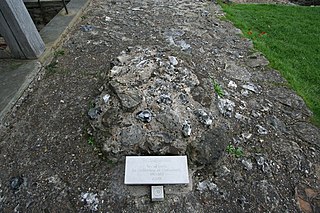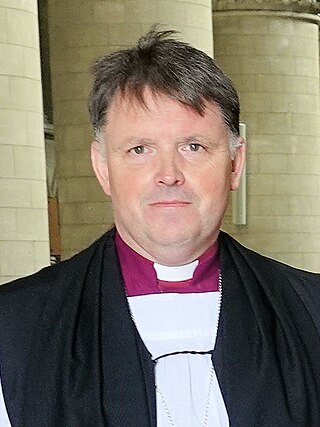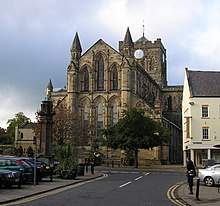
Lindisfarne, also called Holy Island, is a tidal island off the northeast coast of England, which constitutes the civil parish of Holy Island in Northumberland. Holy Island has a recorded history from the 6th century AD; it was an important centre of Celtic Christianity under Saints Aidan, Cuthbert, Eadfrith, and Eadberht of Lindisfarne. The island was originally home to a monastery, which was destroyed during the Viking invasions but re-established as a priory following the Norman Conquest of England. Other notable sites built on the island are St. Mary the Virgin parish church, Lindisfarne Castle, several lighthouses and other navigational markers, and a complex network of lime kilns. In the present day, the island is an Area of Outstanding Natural Beauty and a hotspot for historical tourism and bird watching. As of February 2020, the island had three pubs, a hotel and a post office.

Cuthbert of Lindisfarne was an Anglo-Saxon saint of the early Northumbrian church in the Celtic tradition. He was a monk, bishop and hermit, associated with the monasteries of Melrose and Lindisfarne in the Kingdom of Northumbria, today in north-eastern England and south-eastern Scotland. Both during his life and after his death, he became a popular medieval saint of Northern England, with a cult centred on his tomb at Durham Cathedral. Cuthbert is regarded as the patron saint of Northumbria. His feast days are 20 March and 4 September.
Wilfrid was an English bishop and saint. Born a Northumbrian noble, he entered religious life as a teenager and studied at Lindisfarne, at Canterbury, in Francia, and at Rome; he returned to Northumbria in about 660, and became the abbot of a newly founded monastery at Ripon. In 664 Wilfrid acted as spokesman for the Roman position at the Synod of Whitby, and became famous for his speech advocating that the Roman method for calculating the date of Easter should be adopted. His success prompted the king's son, Alhfrith, to appoint him Bishop of Northumbria. Wilfrid chose to be consecrated in Gaul because of the lack of what he considered to be validly consecrated bishops in England at that time. During Wilfrid's absence Alhfrith seems to have led an unsuccessful revolt against his father, Oswiu, leaving a question mark over Wilfrid's appointment as bishop. Before Wilfrid's return Oswiu had appointed Ceadda in his place, resulting in Wilfrid's retirement to Ripon for a few years following his arrival back in Northumbria.

The Cathedral of the Blessed Virgin Mary is a Church of England cathedral in the city of Truro, Cornwall. It was built between 1880 and 1910 to a Gothic Revival design by John Loughborough Pearson on the site of the parish church of St Mary. It is one of only three cathedrals in the United Kingdom featuring three spires.

Hilda of Whitby was a saint of the early Church in Britain. She was the founder and first abbess of the monastery at Whitby which was chosen as the venue for the Synod of Whitby in 664. An important figure in the Christianisation of Anglo-Saxon England, she was abbess in several convents and recognised for the wisdom that drew kings to her for advice.
Hexhamshire is a civil parish in Northern England. It was incorporated into Northumberland in 1572.

Carlisle Cathedral is a Grade I listed Anglican cathedral in the city of Carlisle, Cumbria, England. It was founded as an Augustinian priory and became a cathedral in 1133. It is also the seat of the Bishop of Carlisle.

Eata, also known as Eata of Lindisfarne, was Bishop of Hexham from 678 until 681, and of then Bishop of Lindisfarne from before 681 until 685. He then was translated back to Hexham where he served until his death in 685 or 686. He was the first native of Northumbria to occupy the bishopric of Lindisfarne.

The Bishop of Hexham was an episcopal title which took its name after the market town of Hexham in Northumberland, England. The title was first used by the Anglo-Saxons in the 7th and 9th centuries, and then by the Roman Catholic Church since the 19th century.
Bosa was an Anglo-Saxon Bishop of York during the 7th and early 8th centuries. He was educated at Whitby Abbey, where he became a monk. Following Wilfrid's removal from York in 678 the diocese was divided into three, leaving a greatly reduced see of York, to which Bosa was appointed bishop. He was himself removed in 687 and replaced by Wilfrid, but in 691 Wilfrid was once more ejected and Bosa returned to the see. He died in about 705, and subsequently appears as a saint in an 8th-century liturgical calendar.
This timeline summarises significant events in the history of Northumbria and Northumberland.

Christ Church Cathedral is the cathedral of the Anglican diocese of Oxford, which consists of the counties of Oxfordshire, Buckinghamshire and Berkshire. It is also the chapel of Christ Church, a college of the University of Oxford. This dual role as cathedral and college chapel is unique in the Church of England. This gives the Dean of Christ Church a distinctive role as both head of Christ Church, Oxford as well as having the ecclesiastical function of an Anglican Dean.

Leeds Minster, or the Minster and Parish Church of Saint Peter-at-Leeds is the minster church of Leeds, West Yorkshire, England. It stands on the site of the oldest church in the city and is of architectural and liturgical significance. A church is recorded on the site as early as the 7th century, although the present structure is a Gothic Revival one, designed by Robert Dennis Chantrell and completed in 1841. It is dedicated to Saint Peter and was the Parish Church of Leeds before receiving the honorific title of "Minster" in 2012. It has been designated a Grade I listed building by Historic England.

Fenwick Justin John Lawson, ARCA is an English sculptor based in the north-east of England.

Events from the 7th century in England.

The Diocese of Hexham and Newcastle is a Latin Church diocese of the Catholic Church, centred on St Mary's Cathedral in the city of Newcastle upon Tyne in England. The diocese is one of the six suffragan sees in the ecclesiastical Province of Liverpool and covers the historic boundaries of County Durham and Northumberland.
The Synod of Twyford was a synod of the early English church held in 684 and described by Bede in his Historia ecclesiastica gentis Anglorum, Book IV, ch. 28.

St Cuthbert's Church is a Roman Catholic parish church in Durham, England. It was opened on 31 May 1827 to replace two previous chapels, one run by the secular clergy and the other by the Jesuits. It is also the home of the Durham University Catholic Chaplaincy and Catholic Society. From 2012 to 2016 the parish was entrusted, along with the chaplaincy, to the Dominican Order, and its congregation has since maintained the Dominicans' influence. The church is a protected building, being part of the Elvet Green Conservation Area. It is named for St Cuthbert of Lindisfarne, the 7th century bishop, healer and patron of Northern England.

Graham Barham Usher is an Anglican bishop and ecologist. Since 2019, he has been the Bishop of Norwich; he had previously served as Bishop of Dudley, a suffragan bishop in the Diocese of Worcester.
Alfred, son of Westou was a medieval English priest and relic collector, active in Northumberland. He is now best known for allegedly stealing the remains of Bede and bringing them in secret to the shrine of St Cuthbert in Durham, although some modern scholars consider this unlikely. He is also documented as having translated the remains of Boisil of Melrose Abbey, as well as numerous northern English minor saints of the 7th and 8th centuries: the anchorites Balther and Bilfrid; Acca, Alchmund and Eata, bishops of Hexham; Oswin, king of Deira; and the abbesses Ebba and Æthelgitha. He served as the sacristan at Cuthbert's shrine under three bishops, and was renowned for his devotion to the saint.




















